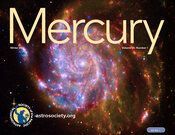Winter 2021 - Volume 50, Number 1

Table of Contents:
[21] Space News
A rundown of some of the most exciting developments in space and time.
[25] The Astronaut Astronomers
Human space crews have conducted astronomy experiments for over 50 years. Their role has changed with the technology — and it may be changing again.
[33] Cosmic Views
The Red Planet has a new rover and multiple orbiters. Here are a few images from these recent Martian guests.
[35] The Triumphs of NASA’s Great Observatories
These four space observatories, which launched between 1990 and 2003, changed astronomy.
Departments:
[3] Perspectives, Liz Kruesi
Welcome to Volume 50
[4] First Word, Linda Shore
The Launch of Mercury
[6] Annals of Astronomy, Clifford J. Cunningham
Dungal and the Eclipses of 810
[8] Armchair Astrophysics, Christopher Wanjek
Blasts from the Past
[10] Research Focus, M. Katy Rodriguez-Wimberly
The Milky Way’s Diverse Companions
[13] Research Focus, James Negus
ALMA’s Glimpse into Protoplanetary Disk Evolution
[15] Education Matters, Brian Kruse
Images of Wonder?
[17] A Little Learning, C. Renée James & Scott T. Miller
Mapping It Out
[41] Reflections, Liz Kruesi
Magnetic Fields Among the Whirlpool
************
The Astronaut Astronomers (Feature)
By Steve Murray
When the crew of Apollo 16 landed on the Moon in April 1972, they set up the first astronomical telescope on another world, an instrument that explored the lunar skies in the ultraviolet (UV) band. In the early decades when science needed telescopes above Earth’s atmosphere, it was working space crews who operated them, gathering the data and delivering the results to astronomers back on the ground. While science and technology have changed dramatically in the decades that followed, astronomy has always been woven into the fabric of human spaceflight. Take a tour through these intertwined networks.
Cosmic Views (Feature)
By Liz Kruesi
In February, the United Arab Emirates became only the fifth nation to reach Mars successfully when its Hope spacecraft began orbiting the planet. This Martian weather satellite sent to Earth a stunning image of the planet shortly after. Later in the month, NASA’s Perseverance rover landed safely on Mars, and it began studying the Red Planet’s surface just minutes later.
The Triumphs of NASA’s Great Observatories
By Sarah Wells
Ever since the beginning of NASA’s Great Observatories program, the idea was to coordinate the research of four upcoming space telescopes that would all cast their gazes into a different part of the electromagnetic spectrum, from visible light to X-rays to gamma rays and even into the infrared, to help one another tease apart never-before-seen astrophysical phenomena. Those four observatories — the Hubble Space Telescope, the Chandra X-ray Observatory, the Compton Gamma-Ray Observatory, and the Spitzer Space Telescope — have become a legendary monument to the collaboration and insight of the astronomical community.
